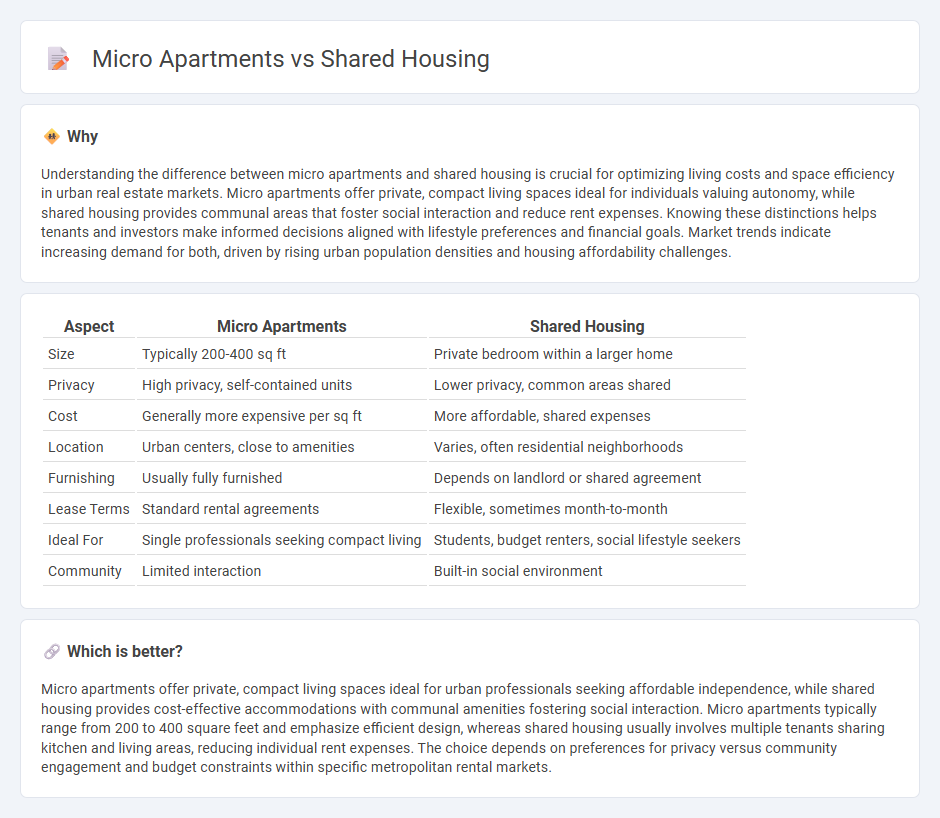
Micro apartments offer compact, efficient living spaces designed for urban professionals seeking affordability and convenience within limited square footage. Shared housing provides a collaborative environment where multiple tenants share common areas, reducing individual costs and fostering community interactions. Explore the benefits and challenges of micro apartments versus shared housing to determine which suits your lifestyle and investment goals.
Why it is important
Understanding the difference between micro apartments and shared housing is crucial for optimizing living costs and space efficiency in urban real estate markets. Micro apartments offer private, compact living spaces ideal for individuals valuing autonomy, while shared housing provides communal areas that foster social interaction and reduce rent expenses. Knowing these distinctions helps tenants and investors make informed decisions aligned with lifestyle preferences and financial goals. Market trends indicate increasing demand for both, driven by rising urban population densities and housing affordability challenges.
Comparison Table
| Aspect | Micro Apartments | Shared Housing |
|---|---|---|
| Size | Typically 200-400 sq ft | Private bedroom within a larger home |
| Privacy | High privacy, self-contained units | Lower privacy, common areas shared |
| Cost | Generally more expensive per sq ft | More affordable, shared expenses |
| Location | Urban centers, close to amenities | Varies, often residential neighborhoods |
| Furnishing | Usually fully furnished | Depends on landlord or shared agreement |
| Lease Terms | Standard rental agreements | Flexible, sometimes month-to-month |
| Ideal For | Single professionals seeking compact living | Students, budget renters, social lifestyle seekers |
| Community | Limited interaction | Built-in social environment |
Which is better?
Micro apartments offer private, compact living spaces ideal for urban professionals seeking affordable independence, while shared housing provides cost-effective accommodations with communal amenities fostering social interaction. Micro apartments typically range from 200 to 400 square feet and emphasize efficient design, whereas shared housing usually involves multiple tenants sharing kitchen and living areas, reducing individual rent expenses. The choice depends on preferences for privacy versus community engagement and budget constraints within specific metropolitan rental markets.
Connection
Micro apartments and shared housing both address urban housing challenges by maximizing limited living space and providing affordable alternatives for city dwellers. These housing models emphasize communal amenities and efficient design to reduce individual costs and foster social interaction. Growing demand in densely populated areas drives innovation in flexible, space-saving real estate solutions.
Key Terms
Co-living
Co-living spaces often blend shared housing and micro apartment features, offering private bedrooms with communal living areas to foster social interaction among residents. These accommodations maximize urban living efficiency by providing affordable rent, flexible leases, and community amenities such as coworking spaces and shared kitchens. Explore the latest trends in co-living to find the perfect balance between privacy and connectivity in modern urban housing.
Space optimization
Shared housing maximizes living areas by dividing larger spaces among multiple occupants, enhancing affordability and social interaction. Micro apartments optimize limited square footage through multifunctional furniture and vertical storage, ideal for urban residents seeking privacy in compact dwellings. Discover effective strategies and key benefits for space optimization in both housing options.
Affordability
Shared housing typically offers lower monthly rent by splitting costs among multiple tenants, making it an attractive option for budget-conscious renters. Micro apartments, while more private, often come with higher per-square-foot pricing due to their premium locations and amenities. Explore detailed comparisons and cost breakdowns to determine which housing solution best fits your financial needs.
Source and External Links
Shared Housing Fact Sheet - VA.gov - Shared housing is defined as two or more people living together in a permanent rental unit, sharing costs like rent and utilities, with all tenants on the lease and having tenancy rights, often used in Rapid Re-Housing programs for homeless individuals.
Shared Housing Fact Sheet - National Alliance to End Homelessness - Shared housing is an affordable housing model where people experiencing homelessness live together in one permanent housing unit to reduce costs and increase housing stability.
Rooms for rent in Charlotte, NC | PadSplit - PadSplit offers affordable furnished rooms for rent with shared housing arrangements that include utilities, wifi, and member screening to foster a safe and cooperative living environment.
 dowidth.com
dowidth.com